Abstract
Digested sludge (DS) is a waste product of anaerobic digestion that is produced during the biodegradation of excess sludge. It cannot be used as a substrate for further biogas production owing to its recalcitrant nature. In the present study, we used a heat treatment technique to convert DABYS microflora (DABYS = digested sludge-assimilating and biogas-yielding soil microflora), which degraded DS and produced methane gas, to a microflora that could produce hydrogen gas from DS. Heat treatment at 80 and 100 °C inactivated the methanogens that consume hydrogen for methane production but did not affect the thermotolerant bacteria. We developed three microflorae (DABYS-A80, DABYS-A100, and DABYS-80B) to exclusively produce hydrogen gas. They included representatives from the anaerobic eubacterial families Clostridiaceae and Enterobacteriaceae. Pseudomonas sp. was also present in DABYS-A80 and DABYS-A100. It is thought that bacteria in the Enterobacteriaceae family or Pseudomonas genus survive heat treatment because they are embedded in microgranules. Enzymatic analysis suggested that the microflorae hydrolyzed DS using cellulase, chitinase, and protease. Under optimum culture conditions, DABYS-A80, -A100, and B-100 produced gas yields of 8.0, 7.1, and 2.6 mL, respectively, from 1.0 g of dried DS.
1. Introduction
Domestic wastewater is often treated with activated sludge comprising aerobic microflorae. However, the method produces huge quantities of microbial biomass (excess sludge). Anaerobic digestion is used to reduce the amount of excess sludge and harvest biogas (60% methane and 40% carbon dioxide) from it. Unfortunately, the overall digestion efficiency of the sludge using traditional digestion technology is only ~30% [1] and a digestion residue, which is called digested sludge (DS) and mainly comprises microbial cell wall material [2], is produced. DS is not available as a substrate for further digestion [3] and has become a major industrial waste in many developed countries, which are currently faced with a shortage of final disposal sites. Therefore, technologies that promote DS digestion should address this critical problem and many strategies to enhance sludge digestion, including thermal treatment, ultrasonic treatment, oxidizing agents, electro-kinetic disintegration, pyrolysis, and enzymatic acid/alkaline hydrolysis, have been reported [4,5]. In a previous study, we developed two microflorae (the digested sludge-assimilating and biogas-yielding soil microflora DABYS-A and -B), both of which were obtained through the enrichment culture of river sediments and can convert DS to methane [6]. DABYS-A produced ~20 mL and DABYS-B produced ~14 mL of methane from 1.0 g of dried DS. Furthermore, the biochemical and molecular biological analysis suggested that the microflorae contained hydrolytic bacteria with cellulase, chitinase, and protease activity; acid/hydrogen-producing bacteria; and methanogens.
Although biogas can be used as an alternative to natural gas, methane is a potent greenhouse gas and its CO2 equivalence values range between 20 and 80 g-CO2eq./g-CH4 [7]. Therefore, hydrogen gas, the combustion of which produces H2O rather than CO2, is regarded as one of the leading options for renewable energy [8]. Because methanogens consume hydrogen or fatty acids as substrates for methane production, the inactivation of methanogens in a microflora by heat treatment leads to the accumulation of hydrogen gas [9,10]. If the methanogenic DABYS microflorae are transformed into hydrogenic ones, renewable biohydrogen can be produced from DS, which is one of the major industrial wastes for many developed nations, and contribute to a sustainable society. Therefore, the objectives of the present study were to develop DS-degrading and hydrogen gas-yielding microflora by heat-treating DABYS-A and -B microflora; characterize their hydrogen gas-producing and enzymatic activities; and identify their constituent bacteria.
2. Materials and Methods
2.1. Chemicals and Materials
Azure cellulose and azure chitin were purchased from Sigma-Aldrich (St. Louis, MO, USA). Standard hydrogen and methane gas were purchased from GL Sciences (Tokyo, Japan). The reagents for molecular biology were purchased from Toyobo (Osaka, Japan), Thermo Fisher Scientific (Waltham, MA, USA), and MP Biomedicals (Santa Ana, CA, USA). All other chemicals were purchased from Wako Pure Chemicals (Kyoto, Japan). The glass and plastic labware used for the enrichment culture were purchased from the Maruemu Corporation (Osaka, Japan) and AS ONE Corporation (Osaka, Japan).
2.2. Preparation of DS
Dewatered DS was obtained from the Northern Yokohama city municipal sewage treatment plant, which possesses anaerobic digestion tanks with a flow rate of 12,500 m3/day. Poly-aluminum chloride (PAC), which is widely used as an inorganic flocculant for dewatering sewage sludge, is toxic to microbes and plants [11,12]. Therefore, it was removed from the dewatered DS by repetitively washing it with tap water. Specifically, 300 g of dewatered DS and 600 mL of tap water were mixed in a 1000 mL beaker. The mixture was then filtered through a threefold layer of gauze to remove the PAC-containing supernatant; this procedure was repeated five times until the pH of the eluate was >6.0. The washed residue was then dried completely in an FSP450 drying oven (Advantec, Tokyo, Japan) at 60 °C for 48 h, crushed into a powder, and screened through a strainer with pores of 1 mm diameter. The DS powder that passed through the strainer was used as a substrate for the enrichment culture. The calorific value of the DS powder used in the present study was analyzed using a TG-DTA thermogravimeter-differential thermal analyzer (Rigaku, Tokyo, Japan) and determined to be 147.9 kJ/g dried DS.
2.3. Heat Treatment of the Microflora and Vial-Scale Dark Fermentation
A 10 mL sample of each DABYS microflora (-A and -B) was incubated at 30, 50, 60, and 80 °C in a TR-2a thermostat incubator or in boiling water (100 °C). Each sample of microflora was cultivated in a 17 mL glass vial to which 100 μL of the inoculum from the heat-treated samples, 10 mL of autoclaved deionized water, and 100 mg of autoclaved DS powder were added. The gas phase (7 mL) in the headspace of each vial was flushed with nitrogen for 1 min and the vial was sealed with a butyl rubber stopper and an aluminum cap. Dark fermentation was allowed to proceed for 1 month at 30, 40, 50, or 60 °C to cultivate the microflora and yield biogas at each temperature.
The gas phase in the headspace of each vial was sampled after the dark fermentation for 1 month to quantitatively evaluate the methane and hydrogen yields. The supernatants were recovered for enzymatic assays. A 100 μL aliquot of each 1-month culture was inoculated into a new vial containing 10 mL of sterile water and 100 mg of DS powder for subculture.
2.4. Bottle-Scale Dark Fermentation
To determine the correlation between the headspace volume of the culture bottle and the hydrogen gas-producing activity of the microflorae, the samples were cultivated in 20, 35, 70, 125, and 225 mL serum bottles. After adding the DS suspension (100 mg DS and 10 mL deionized water), the headspace volumes of the bottles were 10, 25, 60, 115, and 215 mL, respectively. The headspace of each bottle was flushed with nitrogen for 5 min and the bottle was sealed with a butyl rubber stopper and an aluminum cap. Dark fermentation was allowed to proceed for 1 month at the optimal temperature and initial pH for each microflora.
2.5. Biogas Analysis
Methane and hydrogen produced during the 1-month dark fermentation were analyzed using a GC-2014 gas chromatography system with a thermal conductivity detector (GC-TCD, Shimadzu, Kyoto, Japan) under the following conditions: column, Shincarbon ST column 50–80 (2.0 m × 3.0 mm internal diameter (i.d.), Shinwa Chemical Industries, Kyoto, Japan); injection volume, 0.5 mL; carrier gas, argon (43.5 mL/min); and column temperature, 80 °C. The detection limits of the GC-TCD for methane and hydrogen quantification were 0.5 and 0.02 μL, respectively.
2.6. Community Fingerprinting of Microflora
The microbial cells were collected from 1 mL of the subculture by microcentrifugation at 20,000× g for 10 min at 4 °C. Genomic DNA was extracted using a FastDNA SPIN Kit for Soil (MP Biomedicals). The 16S rRNA partial gene fragments corresponding to the V6–V8 region for eubacteria were amplified by a polymerase chain reaction (PCR) using the primer pair F984GC/R1378, as described by Heuer et al. [13], with KOD Fx Neo polymerase (Toyobo). The PCR regimen comprised 1 cycle at 94 °C for 2 min, followed by 34 cycles at 94 °C for 15 s, 50 °C for 30 s, and 68 °C for 30 s.
Denaturing gradient gel electrophoresis (DGGE) analysis of the PCR amplicons was performed using an NB-1480A DGGE system (Nihon Eido, Tokyo, Japan) according to the manufacturer’s instructions. Approximately 1 μg of the amplified product was loaded into each well of 6.0% polyacrylamide gel with a linear 50–70% denaturant gradient. Electrophoresis was performed at a constant voltage of 50 V for 18 h at 58 °C. The gels were stained with 10 μL of SYBR Green (Thermo Fisher Scientific) dissolved in 100 mL of TAE buffer.
2.7. DNA Sequencing of the PCR-DGGE Amplicons
Distinct amplicons were excised from the DGGE gels under a 470 nm light-emitting diode. The excised bands were immersed in 20 μL of TE buffer (pH 8.0) for 72 h at 4 °C to facilitate the extraction of the amplicons. Subsequently, 1 μL of the extract was used to re-amplify the rRNA gene fragments with a set of primers lacking the GC clamp [14,15] using the PCR regimen described above for the DGGE analysis. The resulting PCR products were purified using a GeneJET PCR Purification Kit (Thermo Fisher Scientific) and subjected to direct sequencing using a BigDye™ Terminator v3.1 Cycle Sequencing Kit (Thermo Fisher Scientific). The DNA sequences were then compared with those of known microbial species in GenBank, EMBL, and DDBJ databases using the BLAST algorithm. A phylogenetic tree based on the 16S rRNA gene partial sequence was constructed using the maximum likelihood method in the MEGA11 sequence analysis software program [16].
2.8. Enzyme Assay
An aliquot (2.0 mL) of the 1-month dark fermentation culture was subjected to microcentrifugation at 20,000× g for 10 min at 4 °C. The recovered supernatant was referred to as the enzyme solution. The cellulase and chitinase present in the enzyme solution were quantified using azure cellulose and azure chitin as substrates according to the methods described by Silva et al. [17] and Alves et al. [18], respectively, with some modifications. Briefly, 0.2 mL of enzyme solution, 0.8 mL of 50 mM citrate buffer (pH 5.0), and 5.0 mg of cellulose azure or chitin azure were mixed in a microtube and incubated for 1 h at 50 °C. The tubes were then centrifuged at 20,000× g for 10 min at 4 °C and the absorbance of the supernatants was determined at 540 nm using a GloMax® Discover microplate reader (Promega, Madison, WI, USA). One unit of cellulase or chitinase was defined as the amount of enzyme required to produce an increase of 0.01 over the background in the absorbance at 540 nm in 1 h. The protease activity in the enzyme solution was quantified as μg of trypsin equivalent activity using a Pierce Protease Assay Kit (Thermo Fisher Scientific) according to the manufacturer’s instructions. The mean values and standard deviations from three independent experiments were determined and statistical analyses were performed using the Student’s t-test. The detection limits of the enzyme assays were 0.01 units/mL for cellulase and chitinase, and 0.02 μg/mL trypsin equivalent for protease.
2.9. Statistical Analysis
Statistical analyses for the experimental data were performed using Student’s t-test.
3. Results
3.1. Heat Treatment of the DABYS Microflora
The procedure for the heat treatment is summarized in Table 1 and the biogas yields of the heat-treated DABYS microflora are provided in Figure 1. As with the DABYS-A parent flora that was cultivated for 1 month, the DABYS-A microflora that was treated at 50 or 60 °C for 15 min still produced methane. When the DABYS-A microflora was treated at 80 or 100 °C for 15 min, it produced hydrogen. In contrast, the DABYS-A microflora treated at 121 °C for 15 min did not produce any gas. Likewise, the DABYS-B microflora treated at 50 or 60 °C for 15 min produced methane, just as its parent flora, the microflora treated at 80 °C for 15 min, produced hydrogen. The DABYS-B microflora treated at 100 °C for 15 min did not produce any gas. Subsequently, the DABYS-A treated at 80 °C, the DABYS-A treated at 100 °C, and the DABYS-B treated at 80 °C were subcultured at 30 °C (DABYS-A) or 40 °C (DABYS-B) but produced methane instead of hydrogen (data not shown). To complete the methanogen inactivation, therefore, heat treatment was carried out again for those microflorae with an extended treatment time (30 min) and they were then subcultured. All the microflorae retained stable hydrogen gas production during repeated successive treatments (Figure 2). We designated the DABYS-A treated at 80 °C for 30 min as DABYS-A80, the DABYS-A treated at 100 °C for 30 min as DABYS-A100, and the DABYS-B treated at 80 °C for 30 min as DABYS-B80.

Table 1.
Summary of the heat-treatment procedure and gas production by the treated florae in the dark fermentation.
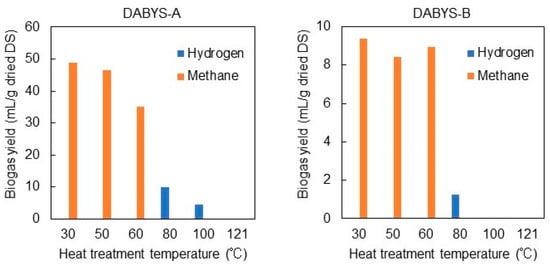
Figure 1.
Biogas yields of the heat-treated DABYS microflorae. Data are means for two-time gas chromatography analysis.
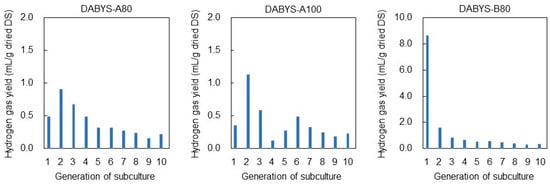
Figure 2.
Hydrogen gas yields of DABYS-A80, -A100, and -B80 through repeated subcultures. Data are means for two-time gas chromatography analysis.
3.2. Enzyme Activity of the Heat-Treated DABYS Microflora
We investigated the enzyme activity of DABYS-A80, -A100, and -B80 (Figure 3). The cellulase and chitinase activities of the microflorae resembled those of their parent microflorae; there were no significant differences in enzyme activity between the heat-treated florae and the parent florae. In contrast, the protease activity of DABYS-B80 resembled that of its parent microflora but DABYS-A80 and -A100 lost their protease activity.
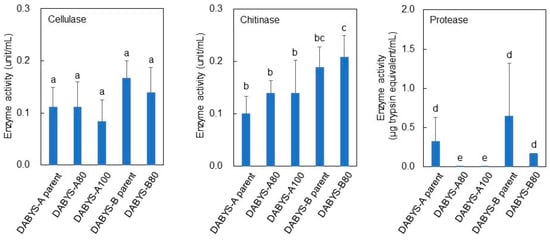
Figure 3.
Cellulase, chitinase, and protease activities of DABYS-A80, -A100, and B80. The data are presented as the mean ± standard deviation of independent triplicates. The letters above the columns indicate significant differences at p < 0.05 (Student’s t-test).
3.3. Bacterial Compositions of the Heat-Treated DABYS Microflorae
Phylogenetic analysis based on the 16S rRNA genes of the bacterial members of DABYS-A80, -A100, and -B80 was carried out using the PCR-DGGE method (Figure 4a,b). All microflorae were mainly composed of the Clostridiaceae and Enterobacteriaceae family strains. Both DABYS-A80 and -A100 contained the Clostridiaceae family strains (amplicons b and c), Enterobacteriaceae family strain (amplicon d), and Pseudomonas sp. strain (amplicon j), which were also present in their parent microflorae. Additionally, the Clostridiaceae and Enterobacteriaceae family members (amplicons f and m), which are minor members of the parent flora, became dominant in DABYS-A80. As for DABYS-A100, some Enterobacteriaceae members (amplicons m and n) and the Clostridium sp. strain (amplicon f) were eliminated by the heat treatment, whereas one Clostridium sp. strain (amplicon k), which was a minor member of the parent flora, became dominant. The Syntrophomonadaceae family strains (amplicon a), which are members of the parent flora, were absent in DABYS-A80 and -A100. In DABYS-B80, some bacteria that were present in the parent microflora (amplicons b, c, and e) survived but the diversity of the Enterobacteriaceae family strains was lost by the elimination of strains corresponding to amplicons d, g, and j in contrast to DABYS-A80 and A100, and the Pseudomonas sp. strain (amplicon a) was also eliminated.
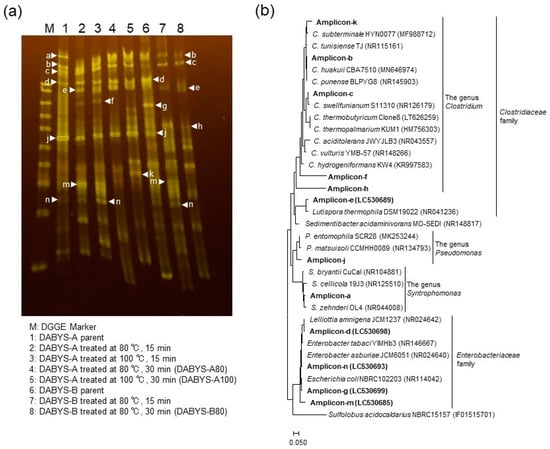
Figure 4.
(a) Denaturing gradient gel electrophoresis (DGGE) band patterns of the heat-treated DABYS microflorae. (b) A phylogenetic tree based on the V6–V8 region of the 16S rRNA genes of the microflora member strains.
3.4. Influences of Temperature and Initial pH on the Hydrogen Gas-Producing Activity of the Microflorae in the Dark Fermentation
We determined the optimal temperatures for hydrogen gas production by DABYS-A80, -A100, and B-80 in the dark fermentation (Figure 5). Although the DABYS-A parent microflora was obtained through the enrichment culture at 30 °C, the optimal temperature for hydrogen gas production by DABYS-A80 and -A100 in the dark fermentation was 40 °C, which was twice that at 30 °C. They did not produce hydrogen gas in the dark fermentation at 50 or 60 °C. The optimal temperature for hydrogen gas production by DABYS-B80 in the dark fermentation was 50 °C, which was twice that at 40 °C, although its parent microflora was obtained through the enrichment culture at 40 °C. DABYS-B80 did not produce hydrogen gas in the dark fermentation at 60 °C.
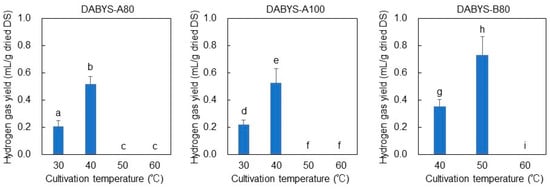
Figure 5.
Influence of temperature on the hydrogenic activity of DABYS-A80, -A100, and -B80 in the dark fermentation. The data are presented as the mean ± standard deviation of independent triplicates. The letters above the columns indicate significant differences at p < 0.05 (Student’s t-test).
We determined the optimal initial pH values for hydrogen gas production by the microflorae at their optimal temperatures: 40 °C for DABYS-A80 and -A100, and 50 °C for DABYS-B80 (Figure 6). The initial pH for the culture medium (the DS suspension) without any pH adjustment was 6.5. None of the microflora produced hydrogen gas at the initial pH values of 2.5 and 4.1. The optimal initial pH for DABYS-A80 and -A100 was 4.8, at which time the gas yield increased four times compared with that at pH 6.5, and the final pH of the culture reached 5.8 after the 1-month dark fermentation. The optimal initial pH for DABYS-B80 was 6.3; the gas yield increased 1.5 times compared to that at pH 6.5, and the final pH of the culture reached 6.4 after the 1-month dark fermentation.
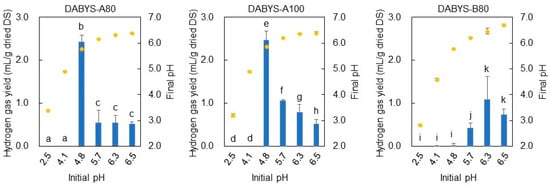
Figure 6.
Influence of the initial pH on the hydrogen gas-producing activity of DABYS-A80, -A100, and -B80 (blue columns), and the final pH (yellow dots) after the 1-month dark fermentation. The data are presented as the mean ± standard deviation of independent triplicates. The letters above the columns indicate significant differences at p < 0.05 (Student’s t-test).
3.5. Influence of Headspace Volume on the Hydrogen-Producing Activity of the DABYS Microflorae in the Dark Fermentation
DABYS-A80, -A100, and -B80 were cultivated in serum bottles with various headspace volumes and the changes in their hydrogen gas-producing activity were determined (Figure 7). Increasing the headspace volume of the bottle resulted in dramatic increases in the hydrogen gas yields of DABYS-A80 (8.0 mL of hydrogen gas from 1.0 g of dried DS at maximum) and -A100 (7.1 mL from 1.0 g of dried DS at maximum). The gas yield of DABYS-A80 peaked at a headspace volume of 60 mL and that of DABYS-A100 increased in proportion to the headspace volume, increasing even in a headspace of 220 mL, i.e., the maximum volume tested. In contrast, the hydrogen gas yield of DABYS-B80 was 2.6 mL of hydrogen gas from 1.0 g of dried DS at maximum and peaked at a headspace volume of 25 mL.
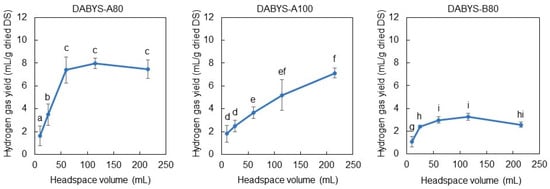
Figure 7.
Influence of headspace volume on the hydrogen-producing activity of DABYS-A80, -A100, and -B80 in the 1-month dark fermentation. The data are presented as the mean ± standard deviation of independent triplicates. The letters indicate significant differences at p < 0.05 (Student’s t-test).
4. Discussion
In the present study, we attempted to transform DABYS-A and -B microflorae into microflorae that could produce hydrogen gas from DS as a substrate. Some hydrogen gas-producing bacteria (members of the Clostridiaceae and Bacteroidetes families, for instance) are known to form thermotolerant spores [19]. Therefore, we hypothesized that heating DABYS-A and DADYS-B would inactivate their methanogens and that their thermotolerant bacteria would produce hydrogen gas. Eventually, we found that heat treatment at 80 °C for 30 min was ideal for the complete inactivation of the methanogens. Considering that hydrogen gas production was observed in the dark fermentation in which the microflorae were fed with DS as the sole substrate, they seem to have used hydrolase enzymes for DS solubilization. We examined the enzyme activity in the culture supernatants of the microflorae and detected cellulase and chitinase for all microflorae, and protease activity for DABYS-B80. Although the DABYS-B parent flora possesses weak protease activity, it was reduced to an undetectable level in the culture supernatants of the DABYS-A80 and -A100. Because cellulose and peptidoglycans derived from bacterial cell walls and chitin derived from fungal cell walls are the major components of DS [20], it is thought that their hydrolase enzymes contribute to DS solubilization.
The PCR-DGGE analysis of the DABYS microflora indicated that the Clostridiaceae and Enterobacteriaceae family strains were the major members. The Clostridiaceae family contains thermotolerant and hydrogenic species, as described above, and some strains are known to produce cellulase, chitinase, and protease [21]. Therefore, it is reasonable to assume that Clostridiaceae species become dominant in heat-treated microflorae. Although the Enterobacteriaceae family strains and Pseudomonas spp. did not form thermotolerant spores, they survived the heat treatment. Some Enterobacteriaceae family species have a locus of heat resistance, a genomic island conferring heat resistance [22], and a Pseudomonas strain in anaerobic sludge granules has been reported to survive heat treatment at 80 °C for 2 h [23]. This implies that they survive heat treatment because they are included in microgranules. The optimal temperatures for the dark fermentation of DABYS-A80, -A100, and -B80 were 40, 40, and 50 °C, respectively, although the optimal temperatures for the DABYS-A and DABYS-B parent microflorae were 30 and 40 °C, respectively. This suggests that thermophilic strains constitute the majority of heat-treated microflora.
Due to the heat treatment of the DABYS parent microflorae, DABYS-A80 and -A100 lost protease activity, and the DGGE analysis revealed that the strain generating the amplicon n (the amplicon-n strain) was extinct in the bacterial florae. Because some strains of Enterobacter asbunae and Escherichia coli, the closest known relative of the amplicon-n strain, are reported to possess proteolytic activity by secreting extracellular protease [24,25], the amplicon-n strain appeared to be a major contributor to the protease activity of the DABYS-A parent microflorae, and its extinction in DABYS-A80 and -A100 brought a loss of their protease activity.
The optimal pH for DABYS-A80 and -A100 was 4.8 and the pH for the culture of the 1-month dark fermentation was increased to ~5.8, implying that alkaline metabolites such as ammonium and amines result from active DS metabolism during fermentation. Therefore, pH control appears to be essential for the continuous production of hydrogen gas by DABYS-A80 and -A100 in dark fermentation. In contrast, the optimal pH for DABYS-B80 was 6.3 and its culture pH did not change during the 1-month fermentation, with a lower hydrogen gas yield than the DABYS-A microflorae, implying its slow metabolism. All microflorae dramatically lost their hydrogen-producing activity at a pH of 4.1 or 4.8, implying that they received some harmful effects from sharp acidification. Because hydrogenase, which is a key enzyme for hydrogen gas production in dark fermentation, is involved in a reversible ferredoxin oxidoreduction, an increase in hydrogen concentration in the culture accelerates the reduction of ferredoxin, leading to a decrease in hydrogen gas production [26]. Therefore, we determined whether a reduction in the partial pressure of hydrogen in the headspace of the serum bottles facilitated the volatilization of hydrogen gas to the gas phase. Among the microflorae tested, DABYS-A80 and -A100 produced more hydrogen gas than DABYS-B80 at the optimal temperature and pH, and the hydrogen gas yield of DABYS-A100 did not reach its maximum during the experiment. This implies that DABYS-A100 can efficiently convert DS to hydrogen gas in a continuous mode of dark fermentation.
There are some reports of the dark fermentation of DS. Approximately 0.2–1.0 mL of hydrogen gas was produced from 1.0 g of dried DS by the anaerobic flora of a digestion liquor supplemented with a fungal hydrolase enzyme cocktail [27], and 0.9–1.6 mL of hydrogen gas was produced from 1.0 g of dried DS by an anaerobic flora from cow dung [28]. Considering these published data, DABYS-A100 seems worthy of further studies for potential use in industrial applications. Based on a density of hydrogen gas at 40 °C and 1.0 atm (0.078 kg/m3) and its calorific value (142 kJ/g-hydrogen), a calorific value of 1.0 mL hydrogen at 40 °C and 1.0 atm is calculated as 0.011 kJ/mL (by a multiplication of 0.078 mg/mL and 142 J/mg). Therefore, 7.1 to 8.0 mL of hydrogen gas produced by DABYS-A80 and -A100 from 1.0 g of dried DS in a 1-month dark fermentation is estimated to contain 0.078 to 0.088 kJ energy, which is 0.053 to 0.059% of that for 1.0 g of DS (147.9 kJ/g dried DS). The yields of hydrogen gas from DS using the developed microflora did not reach those of raw sewage sludge or food waste from which 56–125 mL of hydrogen gas is generally produced from 1.0 g of volatile solid in a dark fermentation [29], even when considering the problematic biodegradation of DS. Therefore, further investigations into the improvement of fermentation conditions and the employment of physico-chemical pretreatment methods [30,31] to increase the surface-area-to-volume ratio of the DS particles are indispensable for social implementation. Additionally, the isolation of member strains in the bacterial florae and characterization of their DS-degrading and hydrogen-producing ability are necessary for a complete understanding of the mechanisms of DS bioconversion.
5. Conclusions
In the present study, the DABYS microflora, which was able to convert DS to methane, was transformed by heating into DABYS-A80, A100, and B80 microflorae, which were able to produce hydrogen gas from DS in a dark fermentation. The microflorae were mainly composed of thermotolerant bacteria from the Clostridiaceae and Enterobacteriaceae families and the methanogens, which consume hydrogen, were inactivated. The hydrogen yields of the microflorae were improved by optimizing the fermentation temperature and initial pH and reducing the hydrogen gas pressure in the headspace. However, the yields of hydrogen gas from DS using the developed microflora still need to be improved to accelerate hydrogen gas production.
Author Contributions
Conceptualization, K.F.; methodology, Y.H. and K.F.; validation, Y.H., N.A. and K.F.; investigation, Y.H. and K.F.; writing—original draft preparation, Y.H.; writing—review and editing, N.A. and K.F.; supervision, K.F.; project administration, K.F.; funding acquisition, K.F. All authors have read and agreed to the published version of the manuscript.
Funding
This study was funded by a Grant-in-Aid for Scientific Research (C: 22K12430) from the Japan Society for the Promotion of Science, and a Grant from the Research Institute of Science and Technology, Kogakuin University.
Institutional Review Board Statement
Not applicable.
Informed Consent Statement
Not applicable.
Data Availability Statement
The data presented in this study are available on request from the corresponding author.
Conflicts of Interest
The authors declare no conflict of interest.
References
- Xu, Y.; Lu, Y.; Zheng, L.; Wang, Z.; Dai, X. Perspective on enhancing the anaerobic digestion of waste activated sludge. J. Hazard. Mater. 2020, 389, 121847. [Google Scholar] [CrossRef] [PubMed]
- He, H.; Xin, X.; Qiu, W.; Li, D.; Liu, Z.; Ma, J. Waste sludge disintegration, methanogenesis and final disposal via various pretreatments: Comparison of performance and effectiveness. Environ. Sci. Ecotechnol. 2021, 8, 100132. [Google Scholar] [CrossRef] [PubMed]
- Wang, Z.; Liu, T.; Duan, H.; Song, Y.; Lu, X.; Hu, S.; Yuan, Z.; Batstone, D.; Zheng, M. Post-treatment options for anaerobically digested sludge: Current status and future prospect. Water Res. 2021, 205, 117665. [Google Scholar] [CrossRef]
- Elalami, D.; Carrere, H.; Monlau, F.; Abdelouahdi, K.; Oukarroum, A.; Barakat, A. Pretreatment and co-digestion of wastewater sludge for biogas production: Recent research advances and trends. Renew. Sustain. Energy Rev. 2019, 114, 109287. [Google Scholar] [CrossRef]
- Nguyen, V.K.; Chaudhary, D.K.; Dahal, R.H.; Trinh, N.H.; Kim, J.; Chang, S.W.; Hong, Y.; La, D.D.; Nguyen, C.; Ngo, H.H.; et al. Review on pretreatment techniques to improve anaerobic digestion of sewage sludge. Fuel 2021, 285, 119105. [Google Scholar] [CrossRef]
- Kon, A.; Omata, S.; Hayakawa, Y.; Aburai, N.; Fujii, K. Microflora communities which can convert digested sludge to biogas. Environ. Technol. 2022, 43, 2391–2403. [Google Scholar] [CrossRef]
- Balcombe, P.; Speirs, J.F.; Brandon, N.P.; Hawkes, A.D. Methane emissions: Choosing the right climate metric and time horizon. Environ. Sci. Process. Impacts 2018, 20, 1323–1339. [Google Scholar] [CrossRef]
- Guilbert, D.; Vitale, G. Hydrogen as a clean and sustainable energy vector for global transition from fossil-based to zero-carbon. Clean Technol. 2021, 3, 881–909. [Google Scholar] [CrossRef]
- Jadhav, D.A.; Chendake, A.D.; Schievano, A.; Pant, D. Suppressing methanogens and enriching electrogens in bioelectrochemical systems. Bioresour. Technol. 2019, 277, 148–156. [Google Scholar] [CrossRef]
- Pachapur, V.L.; Kutty, P.; Pachapur, P.; Brar, S.K.; Bihan, Y.L.; Galvez-Cloutier, R.; Buelna, G. Seed pretreatment for increased hydrogen production using mixed-culture systems with advantages over pure-culture systems. Energies 2019, 12, 530. [Google Scholar] [CrossRef]
- Chen, Y.; Wu, Y.; Wang, D.; Li, H.; Wang, Q.; Liu, Y.; Peng, L.; Yang, Q.; Li, X.; Zeng, G.; et al. Understanding the mechanisms of how poly aluminium chloride inhibits short-chain fatty acids production from anaerobic fermentation of waste activated sludge. Chem. Eng. J. 2018, 334, 1351–1360. [Google Scholar] [CrossRef]
- Fujii, K.; Kai, Y.; Matsunobu, S.; Sato, H.; Mikami, A. Isolation of digested sludge-assimilating fungal strains and their potential applications. J. Appl. Microbiol. 2013, 115, 718–726. [Google Scholar] [CrossRef]
- Heuer, H.; Krsek, M.; Baker, P.; Smalla, K.; Wellington, E.M.H. Analysis of actinomycete communities by specific amplification of genes encoding 16S rRNA and gel electrophoretic separation in denaturing gradients. Appl. Environ. Microbiol. 1997, 63, 3233–3241. [Google Scholar] [CrossRef]
- Zhou, M.; Hernandez-Sanabria, E.; Guan, L.L. Characterization of variation in rumen methanogenic communities under different dietary and host feed efficiency conditions, as determined by PCR-Denaturing gradient gel electrophoresis analysis. Appl. Environ. Microbiol. 2010, 76, 3776–3786. [Google Scholar] [CrossRef]
- May, L.A.; Smiley, B.; Schmidt, M.G. Comparative denaturing gradient gel electrophoresis analysis of fungal communities associated with whole plant corn silage. Can. J. Microbiol. 2001, 47, 829–841. [Google Scholar] [CrossRef]
- Tamura, T.; Stecher, G.; Kumar, S. MEGA11: Molecular Evolutionary Genetics Analysis Version 11. Mol. Biol. Evol. 2021, 38, 3022–3027. [Google Scholar] [CrossRef]
- Silva, J.C.R.; Salgado, J.C.S.; Vici, A.C.; Ward, R.J.; Polizeli, M.L.T.W.; Guimarães, L.H.S.; Furriel, R.P.M.; Jorge, J.A. A novel Trichoderma reesei mutant RP698 with enhanced cellulase production. Braz. J. Microbiol. 2020, 51, 537–545. [Google Scholar] [CrossRef]
- Alves, T.B.; de Oliveira Ornela, P.H.; de Oliveira, A.H.C.; Jorge, J.A.; Guimarães, L.H.S. Production and characterization of a thermostable antifungal chitinase secreted by the filamentous fungus Aspergillus niveus under submerged fermentation. 3 Biotech 2018, 8, 369. [Google Scholar] [CrossRef]
- Kumar, G.; Cho, S.K.; Sivagurunathan, P.; Anburajan, P.; Mahapatra, D.M.; Park, J.H.; Pugazhendhi, A. Insights into evolutionary trends in molecular biology tools in microbial screening for biohydrogen production through dark fermentation. Int. J. Hydrogen Energy 2018, 43, 19885–19901. [Google Scholar] [CrossRef]
- Ghassemi, N.; Poulhazan, A.; Deligey, F.; Mentink-Vigier, F.; Marcotte, I.; Wang, T. Solid-state NMR investigations of extracellular matrixes and cell walls of algae, bacteria, fungi, and plants. Chem. Rev. 2022, 122, 10036–10086. [Google Scholar] [CrossRef]
- Matsushita, O.; Okabe, A. Clostridial hydrolytic enzymes degrading extracellular components. Toxicon 2001, 39, 1769–1780. [Google Scholar] [CrossRef]
- Mercer, R.G.; Walker, B.D.; Yang, X.; McMullen, L.M.; Ganzle, M.G. The locus of heat resistance (LHR) mediates heat resistance in Salmonella enterica, Escherichia coli and Enterobacter cloacae. Food Microbiol. 2017, 64, 96–103. [Google Scholar] [CrossRef] [PubMed]
- Guo, L.; Li, X.M.; Zeng, G.M.; Zhou, Y. Effective hydrogen production using waste sludge and its filtrate. Energy 2010, 35, 3557–3562. [Google Scholar] [CrossRef]
- Oh, M.; Han, J.W.; Lee, C.; Choi, G.J.; Kim, H. Nematicidal and plant growth-promoting activity of Enterobacter asburiae HK169: Genome analysis provides insight into its biological activities. J. Microbiol. Biotechnol. 2018, 28, 968–975. [Google Scholar] [CrossRef] [PubMed]
- Gheibipour, M.; Ghiasi, S.E.; Bashtani, M.; Torbati, M.B.M.; Motamedi, H. The potential of tannin degrading bacteria isolated from rumen of Iranian Urial ram as silage additives. Bioresour. Technol. Rep. 2022, 8, 101024. [Google Scholar] [CrossRef]
- Ghimire, A.; Frunzo, L.; Pirozzi, F.; Trably, E.; Escudie, R.; Lens, P.N.L.; Esposito, G. A review on dark fermentative biohydrogen production from organic biomass: Process parameters and use of by-products. Appl. Energ. 2015, 144, 73–95. [Google Scholar] [CrossRef]
- Sato, H.; Kuribayashi, K.; Fujii, K. Possible practical utility of an enzyme cocktail produced by sludge-degrading microbes for methane and hydrogen production from digested sludge. New Biotechnol. 2016, 33, 1–6. [Google Scholar] [CrossRef]
- Kuribayashi, K.; Kobayashi, Y.; Yokoyama, K.; Fujii, K. Digested sludge-degrading and hydrogen-producing bacterial floras and their potential for biohydrogen production. Int. Biodeter. Biodegr. 2017, 120, 58–65. [Google Scholar] [CrossRef]
- Ghosh, S. Assessment and update of status of pilot scale fermentative biohydrogen production with focus on candidate bioprocesses and decisive key parameters. Int. J. Hydrogen Energy 2022, 47, 17161–17183. [Google Scholar] [CrossRef]
- Kainthola, J.; Kalamdhada, A.S.; Gouda, V.V. A review on enhanced biogas production from anaerobic digestion of lignocellulosic biomass by different enhancement techniques. Process Biochem. 2019, 84, 81–90. [Google Scholar] [CrossRef]
- Almomani, F.; Bhosale, R.R. Enhancing the production of biogas through anaerobic co-digestion of agricultural waste and chemical pre-treatments. Chemosphere 2020, 255, 126805. [Google Scholar] [CrossRef]
Disclaimer/Publisher’s Note: The statements, opinions and data contained in all publications are solely those of the individual author(s) and contributor(s) and not of MDPI and/or the editor(s). MDPI and/or the editor(s) disclaim responsibility for any injury to people or property resulting from any ideas, methods, instructions or products referred to in the content. |
© 2023 by the authors. Licensee MDPI, Basel, Switzerland. This article is an open access article distributed under the terms and conditions of the Creative Commons Attribution (CC BY) license (https://creativecommons.org/licenses/by/4.0/).